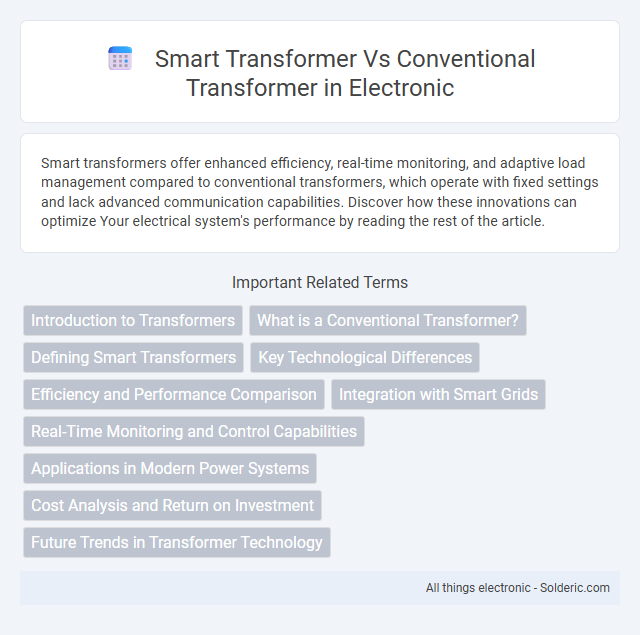Smart transformers offer enhanced efficiency, real-time monitoring, and adaptive load management compared to conventional transformers, which operate with fixed settings and lack advanced communication capabilities. Discover how these innovations can optimize Your electrical system's performance by reading the rest of the article.
Comparison Table
| Feature | Smart Transformer | Conventional Transformer |
|---|---|---|
| Monitoring | Real-time digital monitoring with sensors and IoT integration | No real-time monitoring; manual inspections required |
| Efficiency | Higher efficiency through adaptive load management | Standard efficiency, fixed load handling |
| Maintenance | Predictive and condition-based maintenance enabled | Periodic, scheduled maintenance |
| Fault Detection | Immediate fault detection and alarms | Fault detection during inspections or failures |
| Control | Remote configuration and control via software | Manual controls, limited remote options |
| Cost | Higher upfront cost, lower operational cost | Lower initial cost, higher long-term maintenance cost |
| Integration | Easily integrates with smart grids and energy management systems | Limited integration capabilities |
| Size & Weight | Typically more compact due to advanced materials | Bulkier and heavier |
Introduction to Transformers
Transformers are essential electrical devices that transfer electrical energy between circuits through electromagnetic induction, enabling voltage regulation in power systems. Conventional transformers rely on fixed cores and passive cooling methods, limiting their adaptability and efficiency in dynamic load conditions. Smart transformers integrate advanced sensors and control systems, enhancing real-time monitoring, fault detection, and adaptive load management for improved grid stability and energy efficiency.
What is a Conventional Transformer?
A conventional transformer operates on the principle of electromagnetic induction to transfer electrical energy between two or more coils without changing its frequency, primarily used for voltage regulation in power distribution. It has a fixed design with cores and windings that lack real-time monitoring or adaptive control features. Your power system benefits from conventional transformers in their simplicity and reliability, but they lack the intelligence and efficiency enhancements found in smart transformers.
Defining Smart Transformers
Smart transformers integrate digital technologies, sensors, and communication capabilities to optimize voltage regulation and load management, unlike conventional transformers that rely on static designs and manual control. These advanced transformers enable real-time data monitoring, fault detection, and automated adjustments to improve grid reliability and efficiency. Your electrical infrastructure benefits from enhanced operational flexibility and reduced downtime by adopting smart transformer technology.
Key Technological Differences
Smart transformers integrate digital sensors and advanced communication capabilities enabling real-time monitoring, control, and data analytics, unlike conventional transformers that rely on manual inspections and basic mechanical components. The smart transformer's use of IoT connectivity enhances fault detection and predictive maintenance, reducing downtime and improving grid reliability. Conventional transformers lack embedded intelligence, limiting their responsiveness to dynamic grid demands and integration with modern smart grid infrastructure.
Efficiency and Performance Comparison
Smart transformers enhance efficiency by utilizing real-time monitoring and adaptive load management, reducing energy losses compared to conventional transformers. Advanced sensors and control algorithms in smart transformers optimize voltage regulation and minimize overheating, resulting in improved performance and longer equipment lifespan. Conventional transformers lack these dynamic capabilities, often leading to higher operational costs and lower system reliability.
Integration with Smart Grids
Smart transformers enhance integration with smart grids by providing real-time data monitoring, automated fault detection, and adaptive load management, enabling more efficient energy distribution and reduced downtime. Conventional transformers lack these intelligent features, relying on manual controls and periodic maintenance, which limits their responsiveness to grid fluctuations. The advanced communication capabilities of smart transformers facilitate seamless interoperability within smart grid infrastructures, optimizing grid stability and resilience.
Real-Time Monitoring and Control Capabilities
Smart transformers integrate advanced sensors and communication technologies to enable real-time monitoring and control, allowing for immediate detection of faults, load changes, and temperature fluctuations. Conventional transformers rely on manual inspections and basic protective devices, lacking continuous data feedback and dynamic response capabilities. The enhanced visibility in smart transformers significantly improves operational efficiency, reliability, and preventive maintenance strategies.
Applications in Modern Power Systems
Smart transformers enhance modern power systems by providing advanced voltage regulation, real-time monitoring, and fault detection, improving grid reliability and efficiency. Unlike conventional transformers, smart transformers support integration with renewable energy sources and enable bidirectional energy flow, facilitating smart grid applications and distributed generation. Your power infrastructure benefits from reduced downtime and optimized energy management through these intelligent devices.
Cost Analysis and Return on Investment
Smart transformers offer higher upfront costs than conventional transformers due to advanced sensors, communication modules, and automation features. However, the improved efficiency, reduced downtime, and remote monitoring capabilities of smart transformers lead to significant operational savings and faster return on investment (ROI). For your power infrastructure, investing in smart transformers can optimize long-term cost efficiency and enhance reliability compared to conventional options.
Future Trends in Transformer Technology
Smart transformers integrate advanced sensors, communication modules, and real-time data analytics to enhance grid reliability and efficiency, setting the stage for widespread adoption in smart grids. Conventional transformers, while reliable, lack the adaptive capabilities necessary for dynamic load management and predictive maintenance, limiting their role in future energy systems. Your energy infrastructure will increasingly rely on smart transformer technology to support renewable integration, automated fault detection, and decentralized energy resources.
smart transformer vs conventional transformer Infographic

 solderic.com
solderic.com